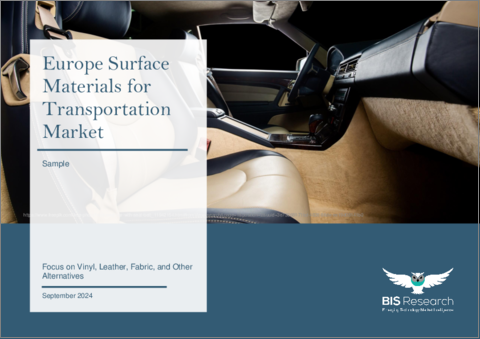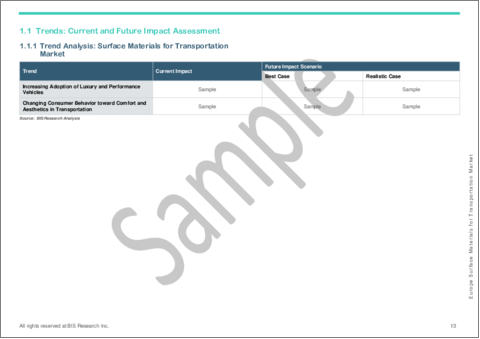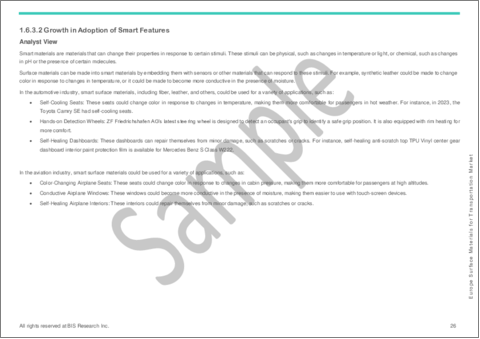|
|
市場調査レポート
商品コード
1561814
欧州の輸送用表面素材市場:ビニール・皮革・布地・その他の代替素材Europe Surface Materials for Transportation Market: Focus on Vinyl, Leather, Fabric, and Other Alternatives |
||||||
カスタマイズ可能
|
|||||||
| 欧州の輸送用表面素材市場:ビニール・皮革・布地・その他の代替素材 |
|
出版日: 2024年09月27日
発行: BIS Research
ページ情報: 英文 77 Pages
納期: 1~5営業日
|
全表示
- 概要
- 図表
- 目次
欧州の輸送用表面素材の市場規模は、2023年の59億7,000万米ドルから、予測期間中はCAGR 7.46%で推移し、2033年には122億7,000万米ドルの規模に成長すると予測されています。
鉄道、自動車、船舶、航空などの主要産業が成長を続ける中、内装材、ダッシュボード、天井材などを含む表面素材は、欧州の輸送事業で高い需要があります。特に、ドイツ、フランス、イタリアなど、欧州の主要経済圏における自動車分野での表面素材の使用拡大が、2023年から2033年にかけての市場の成長を促進すると予測されています。テキスタイル、天然皮革、合成皮革、不織布などの素材動向も、アフターマーケットのカスタマイズ傾向の高まりによって牽引されています。これはおそらく、自動車生産台数の増加とともに市場成長の一助となると思われます。一方で、価格に敏感な欧州市場では、取り付けコストの増大や原材料価格の変動が消費者の取り込みを阻む可能性があり、市場全体の課題となっています。
| 主要市場統計 | |
|---|---|
| 予測期間 | 2023-2033年 |
| 2023年評価 | 59億7,000万米ドル |
| 2033年予測 | 122億7,000万米ドル |
| CAGR | 7.46% |
欧州の輸送用表面素材市場は、自動車のダッシュボード、天井、内装材を供給することで、同地域の大規模な輸送・製造セクターにおいて重要な役割を果たしています。同市場がサービスを提供する重要な産業には、鉄道、自動車、航空、船舶などがあり、いずれも欧州経済にとって不可欠なものです。ドイツ、フランス、イタリアといった国々には定評のある自動車センターが存在するため、優れた最先端素材へのニーズは高まる一方です。
市場は、高級で個性的な自動車内装に対する顧客需要の高まりや、材料工学技術の進歩などによっても活性化しています。リサイクル可能で環境に優しい素材に対する消費者の需要の高まりは、特に欧州の厳しい環境法に照らして、持続可能なソリューションを最優先事項としています。電気自動車 (EV) への移行も、エネルギー効率を支える高度で軽量な表面素材料の必要性をさらに加速させています。
市場の分類
セグメンテーション1:用途別
- 内装
- ヘッドライナー
- ダッシュボード
- その他
セグメンテーション2:販売チャネル別
- OEM
- アフターマーケット
セグメンテーション3:エンドユーザー産業別
- 自動車
- 船舶
- 航空
- 鉄道
セグメンテーション4:素材タイプ別
- ビニール
- 皮革
- 布地
- その他の持続可能な代替素材
セグメンテーション5:国別
- ドイツ
- フランス
- 英国
- イタリア
- その他
当レポートでは、欧州の輸送用表面素材の市場を調査し、業界の動向、技術・特許の動向、法規制環境、市場成長促進要因・抑制要因、市場規模の推移・予測、各種区分・主要国別の詳細分析、競合情勢、主要企業のプロファイルなどをまとめています。
目次
エグゼクティブサマリー
調査範囲
第1章 市場:業界の展望
- 動向:現在および将来の影響評価
- トレンド分析:輸送市場向け表面素材
- 高級車や高性能車の採用増加
- 交通における快適性と美観への消費者行動の変化
- サプライチェーンの概要
- バリューチェーン分析
- 価格予測
- R&Dレビュー
- 特許出願動向 (国・企業別)
- 規制状況
- ステークホルダー分析
- 使用事例
- エンドユーザーと購入基準
- 市場力学の概要
- 市場促進要因
- 市場の課題
- 市場機会
- 表面素材料と自動車の進歩の統合
- 表面素材の選択基準
- 生地と特性の主な比較
- 化学組成の評価
- 用途ごとの互換性
第2章 輸送用表面素材市場:地域別
- 輸送用表面素材市場:地域別
- 地域別概要
- 欧州
- 市場
- 用途
- 製品
- 欧州 (国別)
第3章 市場:競合環境・企業プロファイル
- 次なるフロンティア
- 競合ベンチマーキング
- 市場シェア分析 (素材別)
- 企業プロファイル
- AUTOSTOP AVIATION
- Schoeller Textil AG
- MIKO srl
- Covestro AG
- Continental AG
- BASF SE
- Infinited Fiber Company
第4章 調査手法
List of Figures
- Figure 1: Europe Surface Materials for Transportation Market (by Application), 2022, 2026, and 2033
- Figure 2: Europe Surface Materials for Transportation Market (by Sales Channel), 2022, 2026, and 2033
- Figure 3: Europe Surface Materials for Transportation Market (by End-Use Industry), 2022, 2026, and 2033
- Figure 4: Europe Surface Materials for Transportation Market (by Material Type), 2022, 2026, and 2033
- Figure 5: Surface Materials for Transportation Market, Recent Developments
- Figure 6: Supply Chain Analysis for Surface Materials for Transportation Market
- Figure 7: Patent Filed (by Company), January 2020-December 2023
- Figure 8: Patent Filed (by Country), January 2020-December 2023
- Figure 9: Impact Analysis of Market Navigating Factors, 2022-2033
- Figure 10: Germany Surface Materials for Transportation Market, $Million, 2022-2032
- Figure 11: France Surface Materials for Transportation Market, $Million, 2022-2033
- Figure 12: U.K. Surface Materials for Transportation Market, $Million, 2022-2033
- Figure 13: Italy Surface Materials for Transportation Market, $Million, 2022-2033
- Figure 14: Rest-of-Europe Surface Materials for Transportation Market, $Million, 2022-2033
- Figure 15: Strategic Initiatives, 2020-2023
- Figure 16: Share of Strategic Initiatives
- Figure 17: Data Triangulation
- Figure 18: Top-Down and Bottom-Up Approach
- Figure 19: Assumptions and Limitations
List of Tables
- Table 1: Market Snapshot
- Table 2: Surface Materials for Transportation Market, Regional Opportunities
- Table 3: Surface Materials for Transportation Market (by Region), $Million, 2022-2033
- Table 4: Europe Surface Materials for Transportation Market (by Application), $Million, 2022-2033
- Table 5: Europe Surface Materials for Transportation Market (by Sales Channel), $Million, 2022-2033
- Table 6: Europe Surface Materials for Transportation Market (by End-Use Industry), $Million, 2022-2033
- Table 7: Europe Surface Materials for Transportation Market (by Material Type), $Million, 2022-2033
- Table 8: Germany Surface Materials for Transportation Market (by Application), $Million, 2022-2033
- Table 9: Germany Surface Materials for Transportation Market (by Sales Channel), $Million, 2022-2033
- Table 10: Germany Surface Materials for Transportation Market (by End-Use Industry), $Million, 2022-2033
- Table 11: Germany Surface Materials for Transportation Market (by Material Type), $Million, 2022-2033
- Table 12: France Surface Materials for Transportation Market (by Application), $Million, 2022-2033
- Table 13: France Surface Materials for Transportation Market (by Sales Channel), $Million, 2022-2033
- Table 14: France Surface Materials for Transportation Market (by End-Use Industry), $Million, 2022-2033
- Table 15: France Surface Materials for Transportation Market (by Material Type), $Million, 2022-2033
- Table 16: U.K. Surface Materials for Transportation Market (by Application), $Million, 2022-2033
- Table 17: U.K. Surface Materials for Transportation Market (by Sales Channel), $Million, 2022-2033
- Table 18: U.K. Surface Materials for Transportation Market (by End-Use Industry), $Million, 2022-2033
- Table 19: U.K. Surface Materials for Transportation Market (by Material Type), $Million, 2022-2033
- Table 20: Italy Surface Materials for Transportation Market (by Application), $Million, 2022-2033
- Table 21: Italy Surface Materials for Transportation Market (by Sales Channel), $Million, 2022-2033
- Table 22: Italy Surface Materials for Transportation Market (by End-Use Industry), $Million, 2022-2033
- Table 23: Italy Surface Materials for Transportation Market (by Material Type), $Million, 2022-2033
- Table 24: Rest-of-Europe Surface Materials for Transportation Market (by Application), $Million, 2022-2033
- Table 25: Rest-of-Europe Surface Materials for Transportation Market (by Sales Channel), $Million, 2022-2033
- Table 26: Rest-of-Europe Surface Materials for Transportation Market (by End-Use Industry), $Million, 2022-2033
- Table 27: Rest-of-Europe Surface Materials for Transportation Market (by Material Type), $Million, 2022-2033
- Table 28: Market Share (by Material Type, Vinyl), 2022
- Table 29: Market Share (by Material Type, Leather), 2022
- Table 30: Market Share (by Material Type, Fabric), 2022
- Table 31: Market Share (by Material Type, Sustainable Materials), 2022
Introduction to Europe Surface Materials for Transportation Market
The Europe surface materials for transportation market is projected to reach $12.27 billion by 2033 from $5.97 billion in 2023, growing at a CAGR of 7.46% during the forecast period 2023-2033. Surface materials, which include upholstery, dashboards, headliners, and more, are in high demand in the European transportation business as major industries including rail, automobile, marine, and aviation continue to grow. The growing use of surface materials, particularly in the automotive sector across leading European economies like Germany, France, Italy, and others, is anticipated to propel the market's growth between 2023 and 2033. The market for materials including textiles, natural and synthetic leather, and non-wovens is also being driven by the increasing trend of aftermarket customization. This is probably going to help with market growth along with the increase in car production. However, growing installation costs and fluctuating raw material prices in the price-sensitive European market could prevent consumer uptake, posing a challenge to the broader surface materials sector for transportation.
Market Introduction
| KEY MARKET STATISTICS | |
|---|---|
| Forecast Period | 2023 - 2033 |
| 2023 Evaluation | $5.97 Billion |
| 2033 Forecast | $12.27 Billion |
| CAGR | 7.46% |
The European market for surface materials for transportation plays a crucial role in the region's larger transportation and manufacturing sectors by providing materials for dashboards, headliners, and upholstery in automobiles. Important industries served by the market include rail, automobile, aviation, and maritime, all of which are vital to the European economy. The need for superior and cutting-edge materials is only increasing due to the presence of well-established automotive centers in nations like Germany, France, and Italy.
The market is fueled by things like rising customer demand for high-end, personalized car interiors and advances in material engineering technology. Growing consumer demand for recyclable and environmentally friendly materials has made sustainable solutions a top priority, particularly in light of Europe's strict environmental laws. The transition to electric cars (EVs) further accelerates the need for advanced, lightweight surface materials that support energy efficiency.
However, the market is challenged by rising production and installation costs as well as volatile raw material prices. Despite these challenges, the European surface materials market for transportation is well-positioned to expand thanks to its robust industrial base, innovation-focused approach, and sustainability-focused focus.
Market Segmentation
Segmentation 1: by Application
- Upholstery
- Headliner
- Dashboard
- Others
Segmentation 2: by Sales Channel
- OEM
- Aftermarket
Segmentation 3: by End-Use Industry
- Automotive
- Marine
- Aviation
- Rail
Segmentation 4: by Material Type
- Vinyl
- Leather
- Fabric
- Other Sustatinable Alternatives
Segmentation 5: by Country
- Germany
- France
- U.K.
- Italy
- Rest-of-Europe
How can this report add value to an organization?
Product/Innovation Strategy: The product segment helps the reader understand the different surface materials, various sales channels such as OEM and aftermarket, end-use industries, and different material types involved in the production of surface materials. Moreover, the study provides the reader with a detailed understanding of the Europe surface materials for transportation market based on the end user (automotive, marine, aviation, rail and others).
Growth/Marketing Strategy: The Europe surface materials for transportation market has seen major development by key players operating in the market, such as business expansions, partnerships, collaborations, mergers and acquisitions, and joint ventures. The favored strategy for the companies has been product developments, business expansions, and acquisitions to strengthen their position in the global surface materials for transportation market.
Competitive Strategy: Key players in the Europe surface materials for transportation market analyzed and profiled in the study involve surface materials manufacturers and the overall ecosystem. Moreover, a detailed competitive benchmarking of the players operating in the surface materials for transportation market has been done to help the reader understand how players stack against each other, presenting a clear market landscape. Additionally, comprehensive competitive strategies such as partnerships, agreements, acquisitions, and collaborations will aid the reader in understanding the untapped revenue pockets in the market.
Key Market Players and Competition Synopsis
The companies that are profiled have been selected based on input gathered from primary experts, analyzing company coverage, product portfolio, and market penetration.
Some of the prominent established names in this market are:
- Schoeller Textil AG
- MIKO srl
- Covestro AG
- Continental AG
- BASF SE
Table of Contents
Executive Summary
Scope of the Study
Scope and Definition
1 Market: Industry Outlook
- 1.1 Trends: Current and Future Impact Assessment
- 1.1.1 Trend Analysis: Surface Materials for Transportation Market
- 1.1.2 Increasing Adoption of Luxury and Performance Vehicles
- 1.1.3 Changing Consumer Behavior toward Comfort and Aesthetics in Transportation
- 1.2 Supply Chain Overview
- 1.2.1 Value Chain Analysis
- 1.2.2 Pricing Forecast (by Material Type, $/Meter)
- 1.3 Research and Development Review
- 1.3.1 Patent Filing Trend (by Country, Company)
- 1.4 Regulatory Landscape
- 1.5 Stakeholder Analysis
- 1.5.1 Use Case
- 1.5.2 End User and Buying Criteria
- 1.6 Market Dynamics Overview
- 1.6.1 Market Drivers
- 1.6.1.1 Increase in Demand for Aftermarket Customer Modifications
- 1.6.1.2 Increase in Vehicle Production
- 1.6.2 Market Challenges
- 1.6.2.1 High Material and Installation Cost
- 1.6.2.2 Increase in Regulations for Materials
- 1.6.3 Market Opportunities
- 1.6.3.1 Advancements in Technology for Surface Materials
- 1.6.3.2 Growth in Adoption of Smart Features
- 1.6.1 Market Drivers
- 1.7 Integration of Surface Materials with Ongoing Automotive Advancements
- 1.8 Selection Criteria for Surface Materials
- 1.8.1 Key Comparisons between Fabrics and Properties
- 1.8.1.1 Vinyl
- 1.8.1.2 Natural Leather
- 1.8.1.2.1 Synthetic Leather
- 1.8.1.2.2 Polyurethane (PU)
- 1.8.1.2.3 Polyvinyl Chloride (PVC)
- 1.8.1.2.4 Polyester
- 1.8.1.2.5 Others
- 1.8.1.3 Fabric
- 1.8.1.3.1 Polyester
- 1.8.1.3.2 Natural Fabric
- 1.8.1.3.3 Wool/Nylon Blend
- 1.8.1.4 Other Sustainable Alternatives
- 1.8.1.4.1 Recycled Materials
- 1.8.1.4.2 Plant- and Bio-Based Materials
- 1.8.1.4.3 Bio-Based Fabric
- 1.8.2 Evaluation of Chemical Composition
- 1.8.3 Application-Wise Compatibility
- 1.8.1 Key Comparisons between Fabrics and Properties
2 Surface Materials for Transportation Market (by Region)
- 2.1 Surface Materials for Transportation Market (by Region)
- 2.2 Regional Summary
- 2.3 Europe
- 2.3.1 Market
- 2.3.1.1 Key Market Participants in Europe
- 2.3.1.2 Business Drivers
- 2.3.1.3 Business Challenges
- 2.3.2 Application
- 2.3.3 Product
- 2.3.4 Europe (by Country)
- 2.3.4.1 Germany
- 2.3.4.1.1 Application
- 2.3.4.1.2 Product
- 2.3.4.2 France
- 2.3.4.2.1 Application
- 2.3.4.2.2 Product
- 2.3.4.3 U.K.
- 2.3.4.3.1 Application
- 2.3.4.3.2 Product
- 2.3.4.4 Italy
- 2.3.4.4.1 Application
- 2.3.4.4.2 Product
- 2.3.4.5 Rest-of-Europe
- 2.3.4.5.1 Application
- 2.3.4.5.2 Product
- 2.3.4.1 Germany
- 2.3.1 Market
3 Markets - Competitive Landscaped and Companies Profiled
- 3.1 Next Frontiers
- 3.2 Competitive Benchmarking
- 3.3 Market Share Analysis (by Material Type)
- 3.4 Company Profiles
- 3.4.1 AUTOSTOP AVIATION
- 3.4.1.1 Overview
- 3.4.1.2 Top Products/Product Portfolio
- 3.4.1.3 Top Competitors
- 3.4.1.4 Target Customers/End-Use Industries
- 3.4.1.5 Key Personnel
- 3.4.1.6 Analyst View
- 3.4.1.7 Market Share (2022)
- 3.4.2 Schoeller Textil AG
- 3.4.2.1 Overview
- 3.4.2.2 Top Products/Product Portfolio
- 3.4.2.3 Top Competitors
- 3.4.2.4 Target Customers/End-Use Industries
- 3.4.2.5 Key Personnel
- 3.4.2.6 Analyst View
- 3.4.2.7 Market Share (2022)
- 3.4.3 MIKO srl
- 3.4.3.1 Overview
- 3.4.3.2 Top Products/Product Portfolio
- 3.4.3.3 Top Competitors
- 3.4.3.4 Target Customers/End-Use Industries
- 3.4.3.5 Key Personnel
- 3.4.3.6 Analyst View
- 3.4.3.7 Market Share (2022)
- 3.4.4 Covestro AG
- 3.4.4.1 Overview
- 3.4.4.2 Top Products/Product Portfolio
- 3.4.4.3 Top Competitors
- 3.4.4.4 Target Customers/End-Use Industries
- 3.4.4.5 Key Personnel
- 3.4.4.6 Analyst View
- 3.4.4.7 Market Share (2022)
- 3.4.5 Continental AG
- 3.4.5.1 Overview
- 3.4.5.2 Top Products/Product Portfolio
- 3.4.5.3 Top Competitors
- 3.4.5.4 Target Customers/End-Use Industries
- 3.4.5.5 Key Personnel
- 3.4.5.6 Analyst View
- 3.4.5.7 Market Share (2022)
- 3.4.6 BASF SE
- 3.4.6.1 Overview
- 3.4.6.2 Top Products/Product Portfolio
- 3.4.6.3 Top Competitors
- 3.4.6.4 Target Customers/End-Use Industries
- 3.4.6.5 Key Personnel
- 3.4.6.6 Analyst View
- 3.4.6.7 Market Share (2022)
- 3.4.7 Infinited Fiber Company
- 3.4.7.1 Overview
- 3.4.7.2 Top Products/Product Portfolio
- 3.4.7.3 Top Competitors
- 3.4.7.4 Target Customers/End-Use Industries
- 3.4.7.5 Key Personnel
- 3.4.7.6 Analyst View
- 3.4.7.7 Market Share (2022)
- 3.4.1 AUTOSTOP AVIATION
4 Research Methodology
- 4.1 Data Sources
- 4.1.1 Primary Data Sources
- 4.1.2 Secondary Data Sources
- 4.1.3 Data Triangulation
- 4.2 Market Estimation and Forecast






